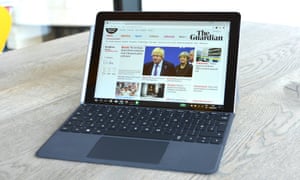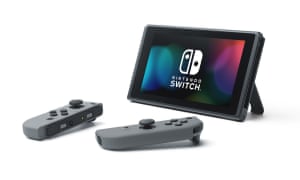Tablet
iPad mini – £399
Tablets can be a handy addition to any student’s toolset, often lasting far longer on a charge than a computer or phone, with a big enough screen to get things done or catch up on the latest episode of The Expanse.
Apple’s recently updated 7.9in iPad Mini is my pick. It’s the best part of £400, but strikes the right balance between power, screen and portability. Pair it with an Apple Pencil (£89) for noting down diagrams, handwritten notes or just doodling.
Plenty of apps cover almost anything you’d want to do. Grab a case that covers the screen and the iPad Mini is fairly robust, which means it should survive trips in various backpacks just fine. There’s a 4G version (£519) if you need data on the move, or the larger but lower-specced and cheaper 9.7in iPad (£319) is available if you want a bigger screen. The 10.5in iPad Air (£479) and 11in iPad Pro (£769) are also options if you want bigger screens and more power.
Alternatives

If you want your tablet to be more computer than giant smartphone, Microsoft’s Surface Go runs full Windows 10, but is the size of an iPad. It starts at £379, but you’ll want the £475 version with more storage, plus the £99 keyboard case and maybe the £99 Surface Pen.
Amazon’s Fire tablets (£50 and up) are great value for watching videos and surfing the web, but as most students will have a smartphone for watching Netflix and YouTube, will be seen by some as an unnecessary extra purchase.
Laptop
Microsoft Surface Laptop 2 – £881

Nothing beats a good laptop if you need to get work done. Microsoft’s Surface Laptop 2 is now a year old but offers the experience of a top-end laptop for less than £1,000.
It runs Windows 10, has a gorgeous 13.5in high density touchscreen, the brilliant Windows Hello facial recognition and battery life to consistently make it through a 12-hour work day.
It has one of the best typing experiences available on any keyboard. It’s a bit different too, with a smooth metal lid but fabric-covered deck.
The port selection is a bit slim with no USB-C, but at least it has a full-sized USB and mini DisplayPort.
Alternatives

If you don’t need a full PC, then Dell’s £229 Chromebook 11 might do the job on the cheap. ChromeOS means it will perform well, with excellent browsing and web apps, but it won’t run traditional desktop applications.
Apple’s new 13in MacBook Air is more expensive at £1,099, but equally good, particularly if you have an iPhone or an iPad. It’s slim, light, lasts about nine hours between charges and has two USB-C/Thunderbolt 3 ports.
Smartphone
OnePlus 7 – £499

If you want one of the best phones you can buy for as little money as possible, that’s the OnePlus 7. It has top-of-the-line performance yet lasts 34 hours between charges. The 6.41in OLED screen is great, with slim bezels around the edges meaning the phone isn’t too enormous even though the screen is big. It runs a custom version of Android 9 Pie called OxygenOS, which is one of the best available. It even has the best in-screen fingerprint scanner available which matches the speed and accuracy of traditional sensors. Even the vibration haptics are great, as is the camera, even if it lacks optical zoom or an ultra-wide angle camera.
It lacks wireless charging, and it only comes in mirror grey, but you can always put a case on it.
Alternatives

If you want something cheaper, the Xiaomi Mi A2 (£260) offers serious value with quality Android One software, a snappy experience and good screen.
Apple users should consider the iPhone XR at £749, or cheaper if you have another iPhone to trade in. Long battery life and slightly cheaper price make the iPhone XR a winner.
Note-taking apps
Evernote – free

Whatever you’re studying, a good note-taking app is worth its weight in gold. Evernote is my all-time favourite: available on everything – be it your phone, tablet, laptop or in a browser.
You can attach pretty much anything to a note, set reminders, record audio, handwrite notes, take camera snaps or, of course, type into a note.
And practically everything syncs with Evernote too, so getting things into notes from other apps or services is a doddle.
It’s free, but there’s a premium option for £4.99 a month which allows you to search in pdfs and annotate them, and provides more storage for syncing notes. There’s a student discount of 50% up for grabs, too.
Alternatives

Evernote’s biggest rival is Microsoft’s OneNote. Like Evernote, it’s free to use, is available on practically everything and has better stylus support on Windows. If you don’t get on with Evernote, try OneNote.
Google’s Keep is a lighter, simpler note keeper and integrated with the rest of the Google apps, which is fine for taking basic notes. Apple’s Notes is included with iOS and MacOS and works well for note taking, but isn’t available on Windows except through a browser.
Gaming
Nintendo Switch – £280

Everyone’s a gamer now, and while a decent phone or tablet can play Fortnite, for social gaming there’s one obvious choice: the Nintendo Switch. Slot the handheld into its dock connected to a TV and four of you can duke it out in Smash Bros Ultimate (£48) or race in fan-favourite Mario Kart 8 Deluxe (£41).
But the Switch plays just as well handheld, with two built in controllers that can be slid off the side for impromptu two-player games in the pub, the coffee shop, in lectures, pretty much anywhere. It’ll also play Fortnite and many single-player games, too.
Nintendo recently released a slightly improved version of the Switch with longer battery life, so make sure you buy the new one, not the old one, if you can. (Look for the newer red box.)
Alternative

If the Switch isn’t your jam, Microsoft’s Xbox One S (from £180) is arguably the next best thing for social gaming with access to a solid library of indie games and perennial favourites such as the Halo series, Fortnite, Call of Duty, Forza and others. There’s an “all digital” Xbox One S, but the version with the disc drive can play DVDs and Blu-rays, so that’s worth it if the price is close.
This article contains affiliate links, which means we may earn a small commission if a reader clicks through and makes a purchase. All our journalism is independent and is in no way influenced by any advertiser or commercial initiative. By clicking on an affiliate link, you accept that third-party cookies will be set. More information.
2019-08-31 06:01:00Z
https://www.theguardian.com/money/2019/aug/31/whats-the-best-tech-to-take-to-university
Bagikan Berita Ini















0 Response to "What's the best tech to take to university? - The Guardian"
Post a Comment